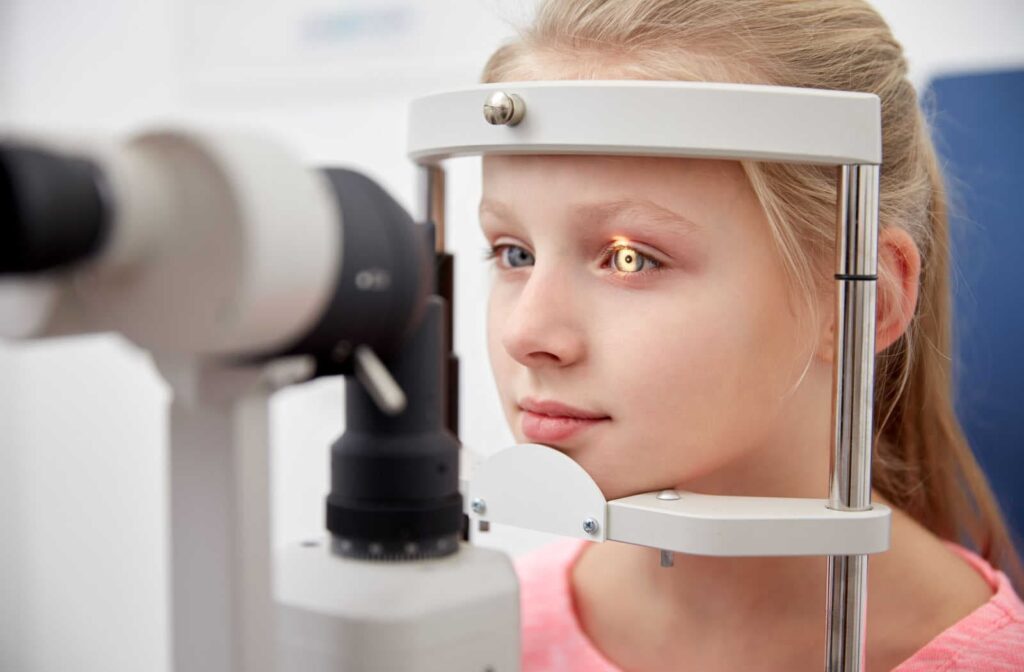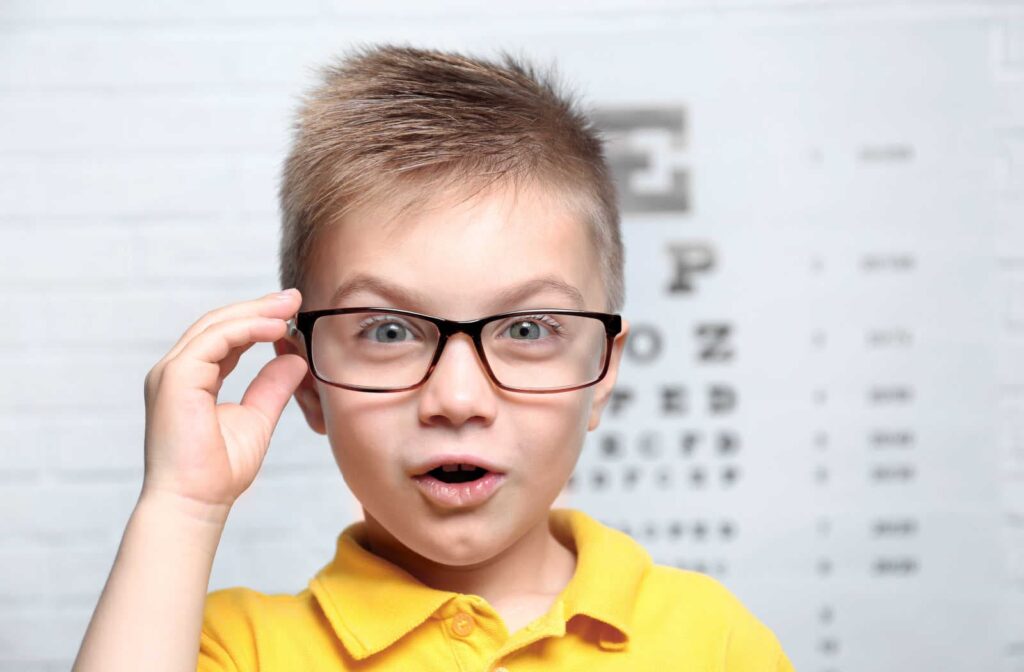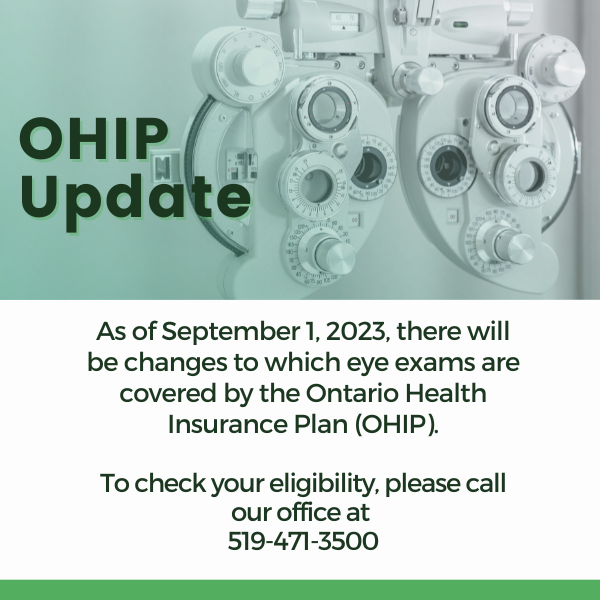As a parent, it’s important to ensure your child’s vision is healthy. One way to do this is by scheduling regular eye exams. Children’s eyes constantly change as they grow. So a regular eye exam can diagnose vision problems early before they cause permanent damage.
The Canadian Association of Optometrists suggests school-age children have an eye exam at least once a year. Certain eye conditions, such as myopia, can progress, but your optometrist can offer treatment options to control its development.
The Importance of Regular Eye Exams
When babies are born with healthy vision and eyes, they have all the necessary structures to see, but they simply aren’t developed enough to see beyond blurred patterns of light and dark. It’s not until they’re older that their eyes begin to work together. This visual growth plays a significant role in their early development, so it’s recommended to follow these guidelines for eye exam frequency:
- A first exam between 6–9 months
- A second exam between 2–5 years
- Yearly exams between 6–19 years
Children with vision conditions or who are at high risk of developing vision conditions might require more frequent check-ups.
These early eye exams are essential as many serious eye conditions don’t have obvious symptoms. Additionally, in the first year, an infant could begin showing signs of crossed eyes or a lazy eye. Eyeglasses, contact lenses, or vision therapy can help correct both these conditions with early diagnosis and treatment.
Myopia, or Nearsightedness
Myopia is one of the most common visual conditions detected in children and affects nearly 30% of Canadians. It’s a refractive error in which the shape of your eye prevents light from correctly focusing on the layer of photoreactive cells on the back of your eye, known as the retina. This condition causes close-up objects to remain clear while faraway objects are blurry.
Myopia commonly starts during childhood, progressing in severity if not treated, before stabilizing around the age of 20. Here are some factors that could increase the risk of your child being diagnosed with myopia:
- Family history of nearsightedness
- Intense close-up visual work
- Excessive screen time
Eyeglasses and contact lenses can help with blurry vision, but your optometrist can also offer myopia control methods. These methods not only help your child see clearly, but they can also help slow down myopia’s progression.

What Happens at a Kid’s Eye Exam?
During a kid’s eye exam, your optometrist will check for visual acuity, muscle control, and general eye health. Since signs of eye problems can be subtle and children sometimes have trouble describing vision issues, a comprehensive eye exam is one of the best ways to diagnose eye conditions.
Infants and toddlers will have their general eye health tested, including pupil response, eye muscles, and focusing ability. Even at this early age, these tests can help indicate a refractive error.
Older kids should be prepared to have more involved tests. Many of these tests will mirror the tests you have in your own eye exams. Some of the abilities a comprehensive eye exam might test for include:
- Visual acuity
- Depth perception
- Eye muscle control
- Hand-eye coordination
- Colour vision
Your child will use their vision to learn and grow at this age. These tests help your optometrist recognize potential vision problems affecting your child’s development, especially since a visual problem could be misdiagnosed as other developmental issues such as ADHD.
Some tests include reading letters off a chart, following moving objects, or testing for colour vision using a colour plate. Your child might also have their eyes dilated using eye drops, allowing your optometrist to see clearly into their eye and inspect their retina.
If your child does have a vision problem, your optometrist might prescribe corrective eyewear such as glasses or contact lenses.
Protecting Your Child’s Vision Between Eye Exams
Between eye exams, you should be alert for any symptoms indicating your child has a vision problem. If you notice any of these symptoms book an eye exam with your optometrist:
- Red, scratchy, or watering eyes
- Light sensitivity
- Excessive squinting or blinking
- Rubbing the eyes
- Inability to concentrate
- Covering or closing one eye
- Holding objects close to face to inspect them
- Avoiding television or books
- Visible frustration or grimacing
As your child grows older, these vision problems can develop into learning issues. They may not notice they have a vision problem at all before entering school. These vision problems could present as the following symptoms:
- Headaches
- Covering or rubbing their eyes
- Avoiding work that is too close or too far away to see
- Unusual posture
- Losing place while reading
- Confusing or avoiding words while reading
- Performing below their potential
In addition to regular eye exams, there are other things you can do to help protect your child’s vision. These include:
- Making sure your child eats a healthy diet high in fruits and vegetables
- Encouraging your child to spend time outdoors
- Make sure your child wears protective eyewear when playing sports or other activities that could cause eye injuries
- If your child wears corrective eyewear, teaching them how to take care of their glasses or contact lenses
Booking an Eye Exam
Children’s eyes change rapidly as they grow and develop. Therefore, they need regular eye exams to help ensure their vision is healthy and to detect any vision problems. Early detection and treatment can help prevent vision loss and improve your child’s quality of life.
Your child should visit an optometrist annually, unless otherwise recommended. If they haven’t had their eye exam this year, our friendly team at Byron Optometry is excited to see them! Book your appointment today!



